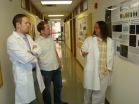(Press-News.org) Like any law-abiding train passenger, a molecule called oskar RNA carries a stamped ticket detailing its destination and form of transport, scientists at the European Molecular Biology Laboratory (EMBL) in Heidelberg, Germany, have found. They show that for this molecule, moving in the right direction isn't enough: speed is of the essence. Their study, published online today in Nature Structural & Molecular Biology, also provides clues as to how a single molecule could receive tickets for different destinations, depending on what type of cell it is in.
For a fruit fly embryo to develop properly, oskar RNA produced by the mother has to enter the egg cell, or oocyte, as it matures, and be taken to one of its ends – the posterior pole. Researchers in Anne Ephrussi's group at EMBL have now found that this movement is more complicated than it seemed. When oskar is processed for transport by a mechanism called splicing, two different tags – SOLE and EJC – are attached to it, next to each other, at a specific spot. Ephrussi and colleagues found that both tags have to be in place for oskar to reach the right destination. Together, they seem to form a ticket that marks oskar for transport to the posterior pole, differentiating it from the many other RNAs that enter the oocyte bound for different destinations.
When they genetically altered the SOLE tag, the scientists found that oskar didn't go to the oocyte's posterior pole, as it should. But surprisingly, it did still move, and seemingly in the right direction. The problem, the researchers realised, was that oskar is racing towards a moving target. As the oocyte grows, it becomes longer, in effect taking the posterior pole further and further away as oskar is carried towards it. With a defective SOLE tag, oskar seemed unable to move fast enough to overcome the oocyte's growth. So somehow this 'ticket' affects the speed of transport, too.
Ephrussi and colleagues are now investigating how SOLE and EJC interact with each other, and how they might influence the cellular machinery that transports oskar. The scientists would also like to explore an interesting possibility raised by their current findings. They discovered that the SOLE tag is only formed if the RNA molecule is spliced. Since some RNAs can be spliced at different spots along their length, this means the same RNA could potentially be issued with tickets for different destinations – for instance, in different cell types – depending on which parts of it are spliced.
INFORMATION:
Need for speed
Molecular ticket determines RNA's destination and speed inside egg cell
2012-03-19
ELSE PRESS RELEASES FROM THIS DATE:
Miami Defense Attorney Diana Gonzalez Runs for Judge
2012-03-19
Ferrer Shane, PL is proud to announce that one of its attorneys, Diana E. Gonzalez, is running for Miami-Dade County Court Judge.
Starting her career in 2004, Diana Gonzalez was rapidly promoted up the ranks in the Public Defender's Office, first handling misdemeanor charges, then defending young people in the juvenile division, to ultimately defending clients charged with the most serious felonies - all in the span of just five years, trying everything from a traffic ticket to a murder case.
Having traveled abroad with the U.S. Department of Defense and with USAID ...
New insight into mechanisms behind autoimmune diseases suggests a potential therapy
2012-03-19
LA JOLLA, Calif., March 18, 2012 – Autoimmune diseases, such as Type I diabetes and rheumatoid arthritis, are caused by an immune system gone haywire, where the body's defense system assaults and destroys healthy tissues. A mutant form of a protein called LYP has been implicated in multiple autoimmune diseases, but the precise molecular pathway involved has been unknown. Now, in a paper published March 18 in Nature Chemical Biology, researchers at Sanford-Burnham Medical Research Institute (Sanford-Burnham) show how the errant form of LYP can disrupt the immune system. ...
UMass Amherst theoretical physicists find a way to simulate strongly correlated fermions
2012-03-19
AMHERST, Mass. – Combining known factors in a new way, theoretical physicists Boris Svistunov and Nikolai Prokof'ev at the University of Massachusetts Amherst, with three alumni of their group, have solved an intractable 50-year-old problem: How to simulate strongly interacting quantum systems to allow accurate predictions of their properties.
It could open the door to practical superconductor applications, as well as to solving difficult "many-body" problems in high-energy physics, condensed matter and ultra-cold atoms.
The theoretical breakthrough by Prokof'ev and ...
Improving Your Doctor's Hygiene
2012-03-19
When people don't feel well, they see a doctor. They probably assume that the doctor will not spread anything to them to make them sicker. Ohio residents may be disturbed to find out that hygiene in hospitals is not as high of a priority as one would expect.
Hospital-acquired infections are the fourth leading cause of death in the United States. A 2004 study done by the American College of Physicians found that only 57 percent of doctors washed their hands when they were supposed to. The study also showed that the busier the doctor was and the more patients needing ...
Columbia Engineering and Penn researchers increase speed of single-molecule measurements
2012-03-19
New York, NY—March 18, 2012—As nanotechnology becomes ever more ubiquitous, researchers are using it to make medical diagnostics smaller, faster, and cheaper, in order to better diagnose diseases, learn more about inherited traits, and more. But as sensors get smaller, measuring them becomes more difficult—there is always a tradeoff between how long any measurement takes to make and how precise it is. And when a signal is very weak, the tradeoff is especially big.
A team of researchers at Columbia Engineering, led by Electrical Engineering Professor Ken Shepard, together ...
A surprising new kind of proton transfer
2012-03-19
When a proton – the bare nucleus of a hydrogen atom – transfers from one molecule to another, or moves within a molecule, the result is a hydrogen bond, in which the proton and another atom like nitrogen or oxygen share electrons. Conventional wisdom has it that proton transfers can only happen using hydrogen bonds as conduits, "proton wires" of hydrogen-bonded networks that can connect and reconnect to alter molecular properties.
Hydrogen bonds are found everywhere in chemistry and biology and are critical in DNA and RNA, where they bond the base pairs that encode genes ...
Genetic variation in East Asians found to explain resistance to cancer drugs
2012-03-19
DURHAM, N.C., AND SINGAPORE – A multi-national research team led by scientists at Duke-NUS Graduate Medical School has identified the reason why some patients fail to respond to some of the most successful cancer drugs.
Tyrosine kinase inhibitor drugs (TKIs) work effectively in most patients to fight certain blood cell cancers, such as chronic myelogenous leukemia (CML), and non-small-cell lung cancers (NSCLC) with mutations in the EGFR gene.
These precisely targeted drugs shut down molecular pathways that keep these cancers flourishing and include TKIs for treating ...
Exotic materials will change optics, Duke researchers say
2012-03-19
DURHAM, N.C. -- Duke University engineers believe that continued advances in creating ever-more exotic and sophisticated man-made materials will greatly improve their ability to control light at will.
The burgeoning use of metamaterials in the field of optics does not rely on the limited set of materials found in nature, but rather man-made constructs that can be designed to control light's many properties. This control is gained by use of metamaterials, which are not so much single substances but entire man-made structures that can be engineered to exhibit properties ...
Special Safety Issues Facing Older Drivers and Pedestrians
2012-03-19
As we most of us already know, aging usually means we'll experience more problems with our hearing, vision and motor skills. In order to grow older safely, we must first recognize our vulnerabilities. Once we do this, we can adapt our behavior in order to create a safer environment for ourselves and everyone else.
The following statistics shed light on the special safety issues facing seniors both behind the wheel and when walking around as pedestrians.
Safety Issues for Senior Drivers/Pedestrians
(Note: In 2009, approximately 40 million Americans were age 65 and ...
Bone marrow transplant arrests symptoms in model of Rett syndrome
2012-03-19
A paper published online today in Nature describes the results of using bone marrow transplant (BMT) to replace faulty immune system cells in models of Rett Syndrome. The procedure arrested many severe symptoms of the childhood disorder, including abnormal breathing and movement, and significantly extended the lifespan of Rett mouse models. Exploring the function of microglia deficient in methyl-CpG binding protein 2 (Mecp2), the protein encoded by the "Rett gene," principal investigator Jonathan Kipnis, Ph.D. and his team at the University of Virginia School of Medicine ...
LAST 30 PRESS RELEASES:
Making lighter work of calculating fluid and heat flow
Normalizing blood sugar can halve heart attack risk
Lowering blood sugar cuts heart attack risk in people with prediabetes
Study links genetic variants to risk of blinding eye disease in premature infants
Non-opioid ‘pain sponge’ therapy halts cartilage degeneration and relieves chronic pain
AI can pick up cultural values by mimicking how kids learn
China’s ecological redlines offer fast track to 30 x 30 global conservation goal
Invisible indoor threats: emerging household contaminants and their growing risks to human health
Adding antibody treatment to chemo boosts outcomes for children with rare cancer
Germline pathogenic variants among women without a history of breast cancer
Tanning beds triple melanoma risk, potentially causing broad DNA damage
Unique bond identified as key to viral infection speed
Indoor tanning makes youthful skin much older on a genetic level
Mouse model sheds new light on the causes and potential solutions to human GI problems linked to muscular dystrophy
The Journal of Nuclear Medicine ahead-of-print tip sheet: December 12, 2025
Smarter tools for peering into the microscopic world
Applications open for funding to conduct research in the Kinsey Institute archives
Global measure underestimates the severity of food insecurity
Child survivors of critical illness are missing out on timely follow up care
Risk-based vs annual breast cancer screening / the WISDOM randomized clinical trial
University of Toronto launches Electric Vehicle Innovation Ontario to accelerate advanced EV technologies and build Canada’s innovation advantage
Early relapse predicts poor outcomes in aggressive blood cancer
American College of Lifestyle Medicine applauds two CMS models aligned with lifestyle medicine practice and reimbursement
Clinical trial finds cannabis use not a barrier to quitting nicotine vaping
Supplemental nutrition assistance program policies and food insecurity
Switching immune cells to “night mode” could limit damage after a heart attack, study suggests
URI-based Global RIghts Project report spotlights continued troubling trends in worldwide inhumane treatment
Neutrophils are less aggressive at night, explaining why nighttime heart attacks cause less damage than daytime events
Menopausal hormone therapy may not pose breast cancer risk for women with BRCA mutations
Mobile health tool may improve quality of life for adolescent and young adult breast cancer survivors
[Press-News.org] Need for speedMolecular ticket determines RNA's destination and speed inside egg cell







